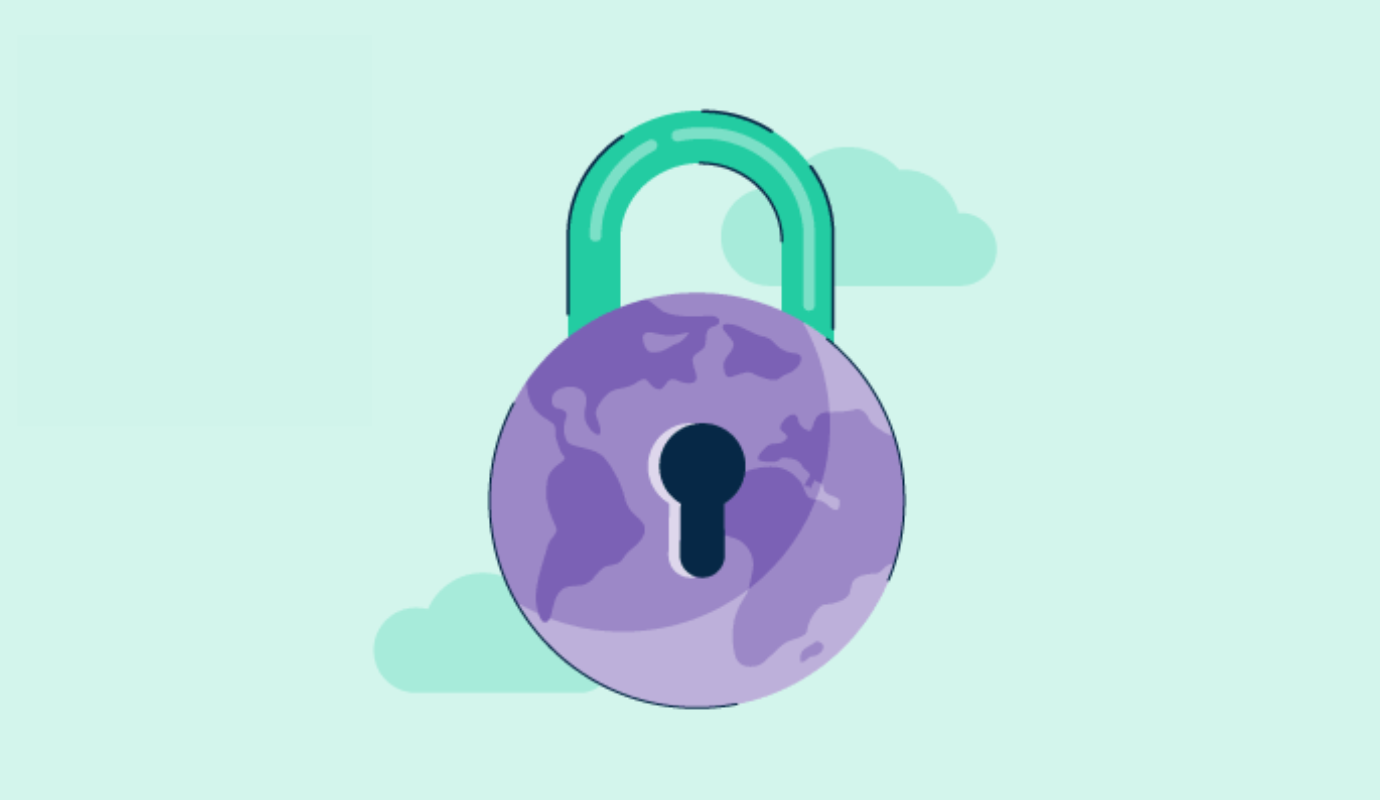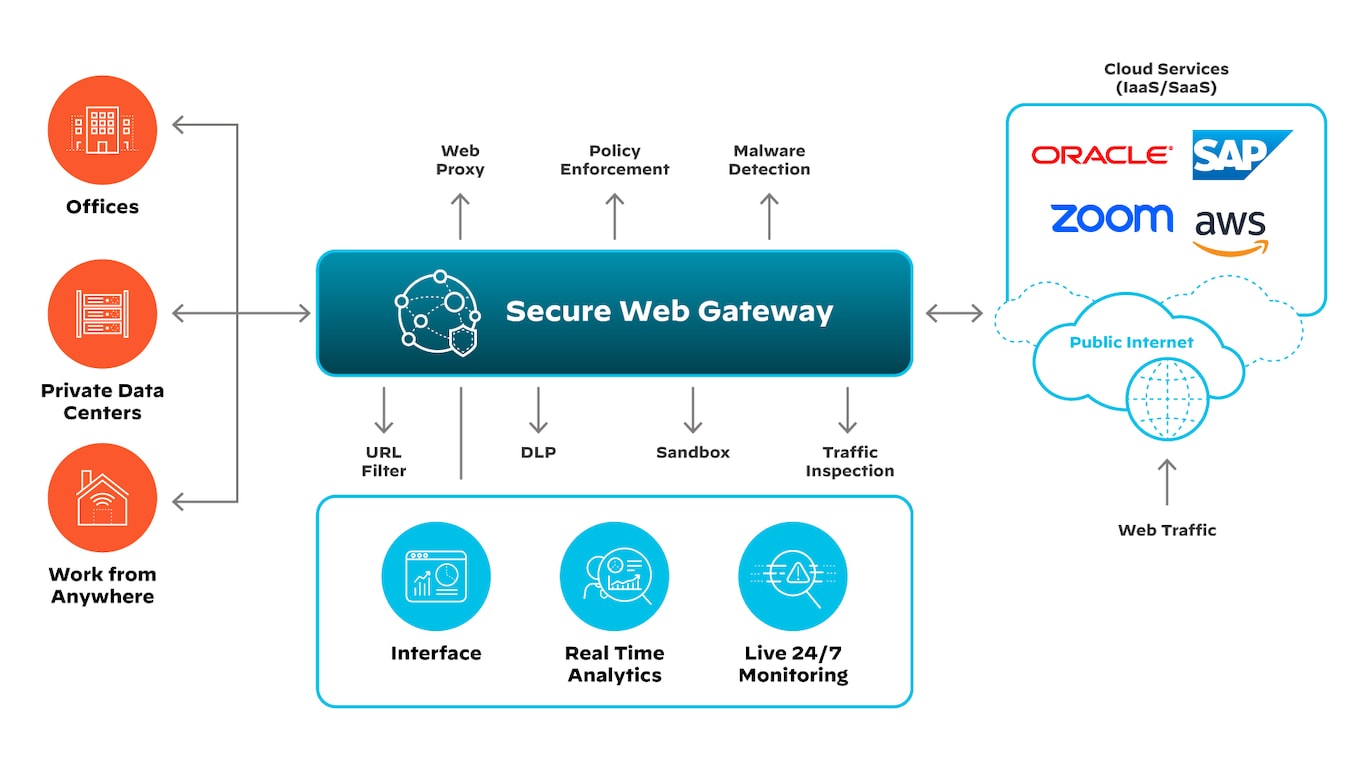December 22, 2024
 by Holly Landis / December 22, 2024
by Holly Landis / December 22, 2024

Cybercriminals are becoming increasingly sophisticated, launching more complex and targeted attacks each year.
As businesses expand their digital footprint, protecting sensitive data from unsafe web traffic and unauthorized user behavior has never been more crucial. While there are many steps you can take to enhance your cybersecurity, one effective solution is deploying Secure Web Gateways (SWGs).
A secure web gateway protects company data and enforces policies to block malicious web traffic, preventing data breaches and cyber threats. It operates between users and the web, ensuring strong security across internal networks.
SWGs act as a powerful defense, filtering internet traffic based on predefined rules, either on-premises or through the cloud.
While primarily focused on preventing external threats, SWGs also help monitor internal activities, providing a comprehensive security layer. For organizations with remote teams or those heavily reliant on the cloud, SWGs are essential in defending against phishing attacks, malware-infected websites, and global hacking attempts.
Read on to discover how SWGs can strengthen your business’s cybersecurity strategy and why they’re vital in today’s threat landscape.
As businesses rely more on the internet, they face growing web-based threats like phishing, malware, and data breaches. Traditional security tools often fail to address these risks, especially in remote and hybrid work environments.
Secure web gateways filter web traffic in real-time, blocking malicious sites, enforcing policies, and providing visibility into user behavior. They also protect against threats such as malware downloads and data leaks, enhancing network security.
SWGs are essential for safeguarding organizations in today’s digital world. They help ensure compliance, protect sensitive data, and prevent productivity losses, making them a crucial part of a comprehensive security strategy.
SWGs work the same way, regardless of whether they’re in the cloud or on a physical server. They’re positioned on the network edge to inspect all traffic coming and going from the network to determine whether it should be allowed, quarantined for further inspection, or blocked.
SWGs are run on proxy servers that make requests on behalf of the device or another server. Since they’re software-only, SWGs need to connect to both a device and the Internet to work effectively.
In reviewing outgoing and incoming traffic, you have to follow two steps.
The reverse happens when traffic and data from the web return to the device before being passed along to users if it passes the security filters.
 Source: paloalto
Source: paloalto
Several aspects of SWGs make this level of monitoring and filtering possible, including:
A secure web gateway primarily filters and manages web traffic that enters a business network, providing protection against malicious websites, phishing attempts, and unsafe downloads. It enforces web-specific security policies, ensuring safe internet usage within the organization.
On the other hand, firewalls offer broader protection and are designed to secure the entire network. They analyze and control incoming and outgoing traffic across all network layers, including non-web traffic, email protocols, file-sharing services, and more. Firewalls work at the perimeter of the network, enforcing security policies and preventing unauthorized access from both external and internal threats.
While SWGs focus on web-based threats, firewalls protect the entire network architecture. Using both in tandem can create a more robust and layered security strategy, addressing threats across all channels.
Cloud access security brokers (CASBs) operate in the rapidly evolving realm of cloud computing, offering a distinct functionality compared to SWGs. While SWGs are tailored for managing and securing traditional web traffic, CASBs are designed to address security gaps in cloud environments, including software as a service (SaaS), platform as a service (PaaS), and infrastructure as a service (IaaS).
CASBs provide organizations enhanced control over user behavior, data usage, and compliance within cloud-based platforms. Their functionality is categorized into four key pillars:
While SWGs are essential for securing traditional web traffic, CASBs extend protection to cloud environments, making them ideal for businesses heavily relying on cloud-based platforms.
Together, these tools can complement each other to provide comprehensive security across both on-premises and cloud environments.
A secure web gateway helps maintain security protocols and protects your data, the most vital aspect of your operations. Some of the most beneficial outcomes of using a SWG are:
While secure web gateways are vital for protecting users, data, and organizations, their implementation can present challenges for IT teams:
As comprehensive web security platforms, SWGs are designed to verify employee security compliance and prevent web-based threats. The gateway stands as a wall between web browsers and endpoint devices to identify potential malware and give companies peace of mind over their internal security.
To be included in the secure web gateway category, platforms must:
Below are the top five secure web gateway software solutions from G2’s Fall 2024 Grid Report. Some reviews may be edited for clarity.
Cisco Umbrella simplifies cybersecurity and compliance through a single cloud-native solution. With DNS-layer security, secure web gateway, CASB, and end-to-end experience, businesses can rest easy knowing they’re protected against any threats from malicious web users.
“Umbrella boasts a vast security database that constantly updates, allowing it to effectively block malicious domains, URLs, and IP addresses. This proactive approach helps prevent users from accessing phishing sites, malware repositories, and other harmful resources.”
- Cisco Umbrella Review, Adrian Alberto P.
“In recent versions there are some problems with SSL/TLS connection. Some clients cannot connect to common-use pages, although it's allowed in policies. In the majority of cases, it is just configuration problems like Root CA installation, but in others, it's just impossible to connect many of them using TLS 1.3.”
- Cisco Umbrella Review, Gerardo H.
As a cloud-native security service edge (SSE), Zscaler Internet Access offers a scalable software as a service (SaaS) platform for cloud security. It can replace legacy network security for advanced support against attacks and data loss with a comprehensive zero-trust approach.
“Seamless internet access management, VPN Services for corporate internet access, and firewall capabilities, Zscaler is quite user-friendly. It helps to centralize all network-related provisions for personal and corporate use.”
- Zscaler Internet Access Review, Kunal G.
“Sometimes you feel it impacts your network speed and latency. And sometimes customer support does not give a proper solution.”
- Zscaler Internet Access Review, Sahil K.
Symantec Web Security Service is a resilient cloud security service that provides proactive web protection. Wherever employees are, your business can promise protection against malicious threats online. Through a diversified network of global data centers, this web security tool offers consistent protection against malware and data leaks.
“Symantec Network Security is very strong in threat detection and also prevention. What makes the integration of sophisticated analytics and in-time monitoring stand out is the quick responses to potential threats. It is very easy to use the interface, and both beginners and also experts can manage. In general, Symantec Network Security provides comprehensive protection without sacrificing usability.”
- Symantec Web Security Service Review, Shahil G.
“The performance takes a hit, especially when dealing with file-based databases like Visual FoxPro. If you're working a lot with those systems, it gets kind of clunky, and it needs some tweaking to run smoother. Compatibility is another headache. It doesn't play nice with some major programs.”
- Symantec Web Security Service Review, Karanveer S.
The Citrix Secure Browser helps corporations protect their networks from browser-based cyber attacks by isolating the web browsing experience and securing remote access to web applications and endpoints. Your team can run on a remote, one-time browser session if they need to access high-risk websites without compromising your overall network.
“As SaaS, the risk of data being compromised is potentially the lowest. It enables hassle-free and focused browsing with site security. The browsing traffic is also low as compared to personal browsing, as it can be accessed with corporate networks on a remote basis with one-time session access. The one-time session makes sure that the security is patched and ensures tracking of each action.”
- Citrix Secure Browser Review, Taruna K.
“Citrix Secure Browser does not support all web applications and is a subscription-based service, which can be expensive for some businesses. It becomes the exclusive source of updates, fixes, and continuous support for businesses utilizing Citrix Secure Browser. The organization's surfing capabilities may be impacted by any problems with Citrix's service.”
- Citrix Secure Browser Review, Min Htet A.
Symantec Web Filter is a subscription service that controls web applications and categorizes the security of billions of URLs into 80 predetermined categories, allowing IT administrators to manage web traffic more easily. With real-time web content protections and threat risk levels, the tool can block over 99% of threats to an organization’s network.
“Symantec WebFilter offers a comprehensive suite of features that makes web filtering a breeze. The ease of use is commendable, with an intuitive interface that makes navigation and operation simple. The implementation process is straightforward, and the customer support team is always ready to assist, making the overall experience smooth. The frequency of use in our organization is high, indicating its reliability and effectiveness.”
- Symantec Web Filter Review, Milhan Ahmed M.
“I prefer more detailed and informative notifications regarding the applications and their vulnerabilities. This would help us further enhance the protection of our work environment.”
- Symantec Web Filter Review, Rohan R.
Protect your business with continuous web traffic monitoring through secure web gateways.
SWGs block malicious sites, detect malware, and prevent phishing attacks, safeguarding employee and customer data in real-time. This proactive security solution ensures compliance, minimizes risks and keeps your network secure—all from one easy-to-use platform.
Securing your data one URL at a time, you build a strong defense against cyber threats while maintaining operational focus.
Want to learn more about securing your web applications? Learn more about web application firewalls to further enhance your cybersecurity strategy.
Holly Landis is a freelance writer for G2. She also specializes in being a digital marketing consultant, focusing in on-page SEO, copy, and content writing. She works with SMEs and creative businesses that want to be more intentional with their digital strategies and grow organically on channels they own. As a Brit now living in the USA, you'll usually find her drinking copious amounts of tea in her cherished Anne Boleyn mug while watching endless reruns of Parks and Rec.
The promise of flexibility and productivity draw people to cloud services, but the extra...
 by Sagar Joshi
by Sagar Joshi
Getting your enterprise network secure is no walk in the digital park. A decade back, network...
 by Soundarya Jayaraman
by Soundarya Jayaraman
Secure access service edge (SASE) architecture combines network and security solutions into a...
 by Sarah Wallace
by Sarah Wallace
The promise of flexibility and productivity draw people to cloud services, but the extra...
 by Sagar Joshi
by Sagar Joshi
Getting your enterprise network secure is no walk in the digital park. A decade back, network...
 by Soundarya Jayaraman
by Soundarya Jayaraman


